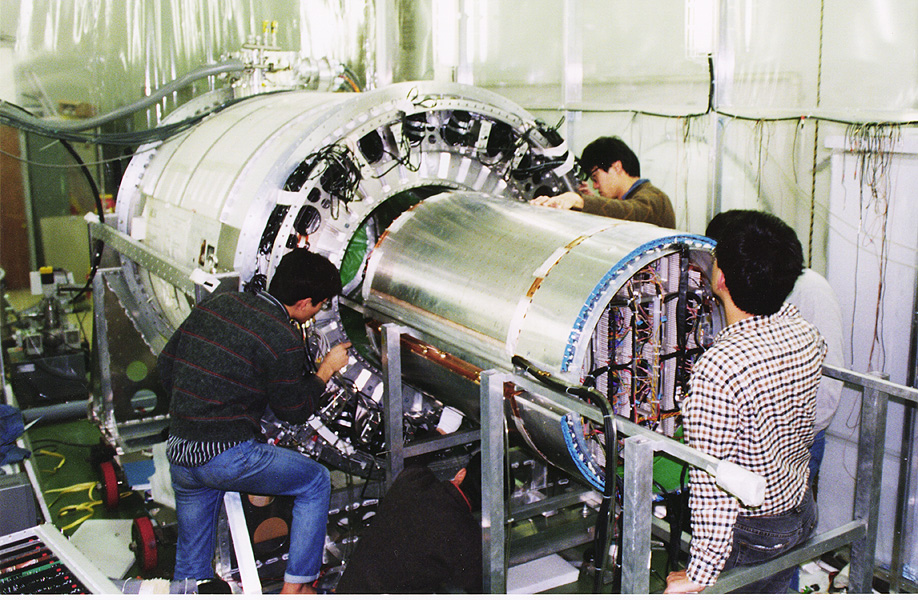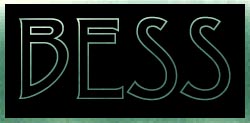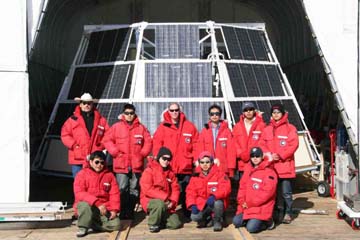

Balloon-borne Experiment with Superconducting Spectrometer
***BESS-Polar (latest instrument in the series)***
was launched from Williams Field, McMurdo, Antarctica at ~1 am EST 12/13/04
and terminated after a successful flight at ~5 pm EST 12/21/04
after ~8 days, 12 hours at float altitude
BESS (the Balloon-borne Experiment
with a Superconducting Spectrometer)
is a joint project of Japanese and US scientists to search for antimatter
in the cosmic radiation, as well as measure energy and intensity of less
exotic components of the cosmic radiation. The antimatter search is of
great interest in that it may provide answers to questions of cosmological
significance dating from the creation of the Universe:
- The BESS collaboration is carrying out a systematic program of measurement of low energy antiprotons in the cosmic radiation. These rare particles are a unique probe to study elementary particle phenomena in the early Universe. Is there an excess of low energy antiprotons beyond that expected from "standard" processes? If so, BESS measurements may provide evidence for the existence of primordial black holes or other forms of dark matter.
- BESS also searches for antihelium in the cosmic radiation, the detection of which would have profound significance for both cosmology and particle physics. Is the Universe "baryon symmetric", that is, does it contain equal amounts of matter and antimatter? Might there exist antimatter galaxies (?) -- discovery of a single antihelium would answer this question.
- Finally, BESS makes precise measurements of the light elements in the cosmic radiation, data that is important both for understanding the physics of cosmic ray transport and to contribute to atmospheric neutrino flux calculations.
The BESS program has had 9 successful flight campaigns since 1993. The
instrument has been modified and improved each year. Evolution of the BESS
instrument and a review of scientific results have been described in
detail elsewhere (Yamamoto, et al., 2003; Mitchell et al., 2004, Yoshida et al., 2004). Historically, the various versions of the BESS instrument
have consisted of large solenoidal thin-wall superconducting magnet, a
time-of-flight system of scintillation counter hodoscopes, inner drift
chambers (IDC), a jet-type drift particle-tracking chamber and an aerogel
Cherenkov counter (which replaced outer drift chambers used in the first
flights). All the components are arranged in a horizontal cylindrical
configuration with the IDC and Jet chambers located inside the warm bore
of the magnet.
The current incarnation of the BESS instrument, BESS-Polar, is similar in
design to previous BESS instruments, but is completely new with an ultra-thin magnet developed at the High Energy Accelerator Research
Organization (KEK) and configured to minimize the amount of material in
the cosmic ray beam, so as to allow the lowest energy measurements of
antiprotons. BESS-Polar has the largest geometry factor of any
balloon-borne magnet spectrometer currently flying, and is ideally suited
to statistics-limited studies of Z=1 and Z=2 components - identifying
antiprotons, and searching for antihelium nuclei in the cosmic radiation.
BESS-Polar has a geometrical acceptance of 0.3 m2-sr, an aerogel Cherenkov
counter with index of refraction n=1.02 and a time-of-flight system with
150 ps resolution, capable of identifying antiprotons over the energy range
from 100 MeV to 4.2 GeV. BESS-Polar is scheduled to make its maiden flight
from McMurdo, Antarctica in December 2004. A second flight at the time of
minimum solar activity is planned for 2007. The extended data-taking
time of long duration flights, the increased event efficiency of the
BESS-Polar configuration and the low geomagnetic cutoff should together
allow an improvement factor of more than 20 over existing low-energy
antiproton data.
 Dr. John Mitchell leads the U.S. BESS program along with Drs. Thomas Hams,
Alex Moiseev, Makoto Sasaki and Robert Streitmatter at NASA/Goddard, Dr.
Jon Ormes at the University of Denver, and Drs. Eun-Suk Seo and MooHyan
Lee at the University of Maryland. The BESS project in Japan is under the
leadership of Dr. Akira Yamamoto, along with Dr. Tetsuya Yoshida at KEK.
Other members of the BESS collaboration in Japan are from the University
of Tokyo, Kobe University and the Institute for Space and Aeronautical
Science (ISAS/JAXA). The BESS-Polar magnet with gas detectors for particle
trajectory measurement and associated electronics were designed and
constructed in Japan. The time-of-flight system and aerogel Cherenkov
detector and associated electronics were designed and constructed by the
U.S. BESS-Polar team. Integration of the new BESS-Polar instrument took
place at Goddard Space Flight Center during the past year. Final test and
integration was done in Palestine, TX in August/September 2004. The U.S.
BESS activities are supported by NASA's Sustaining Research and Technology
(SR&T) program.
Dr. John Mitchell leads the U.S. BESS program along with Drs. Thomas Hams,
Alex Moiseev, Makoto Sasaki and Robert Streitmatter at NASA/Goddard, Dr.
Jon Ormes at the University of Denver, and Drs. Eun-Suk Seo and MooHyan
Lee at the University of Maryland. The BESS project in Japan is under the
leadership of Dr. Akira Yamamoto, along with Dr. Tetsuya Yoshida at KEK.
Other members of the BESS collaboration in Japan are from the University
of Tokyo, Kobe University and the Institute for Space and Aeronautical
Science (ISAS/JAXA). The BESS-Polar magnet with gas detectors for particle
trajectory measurement and associated electronics were designed and
constructed in Japan. The time-of-flight system and aerogel Cherenkov
detector and associated electronics were designed and constructed by the
U.S. BESS-Polar team. Integration of the new BESS-Polar instrument took
place at Goddard Space Flight Center during the past year. Final test and
integration was done in Palestine, TX in August/September 2004. The U.S.
BESS activities are supported by NASA's Sustaining Research and Technology
(SR&T) program.
- Yamamoto, A., et al., 28th Int. Cosmic Ray Conf., Tsukuba, Highlights Tals, 2003
- Mitchell, J.W. et al., Adv. Space res., in press 2004
- Yoshida, T., et al., Adv. Space res., 33-10, 1755, 2004
This page was authored by Dr. Robert Streitmatter of the Laboratory for High Energy Astrophysics (LHEA) at NASA's GSFC.
|